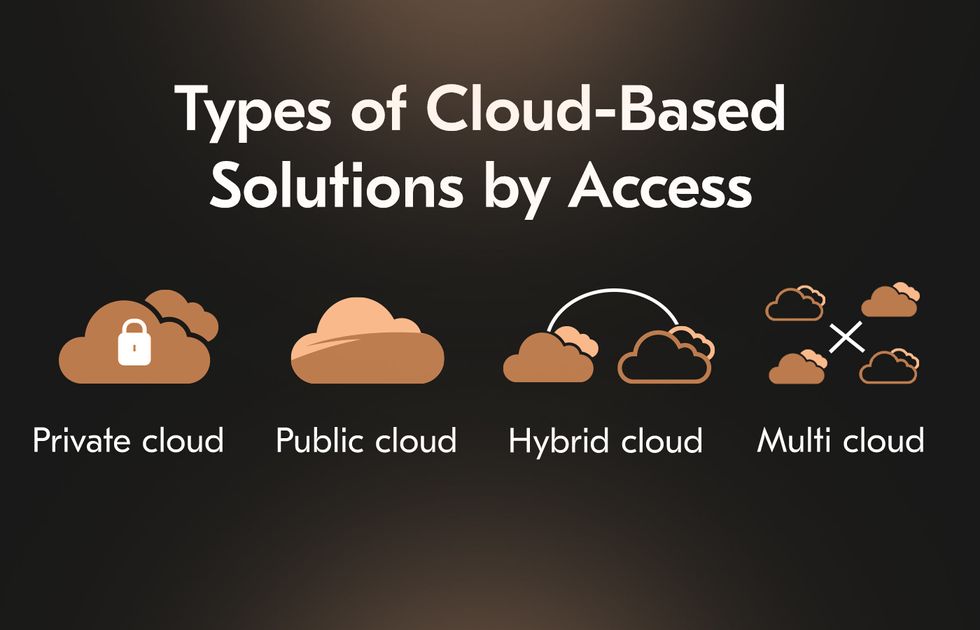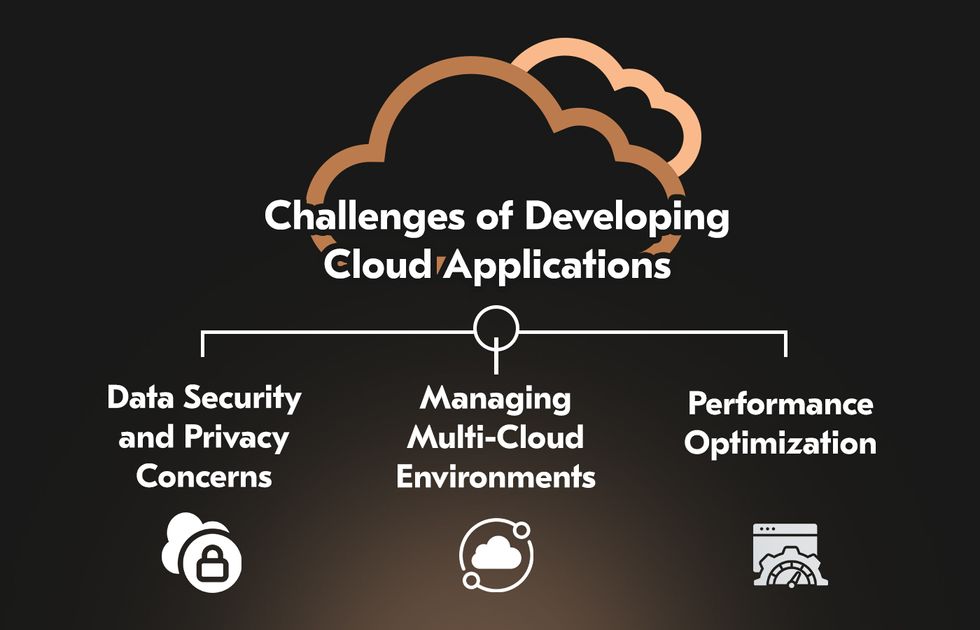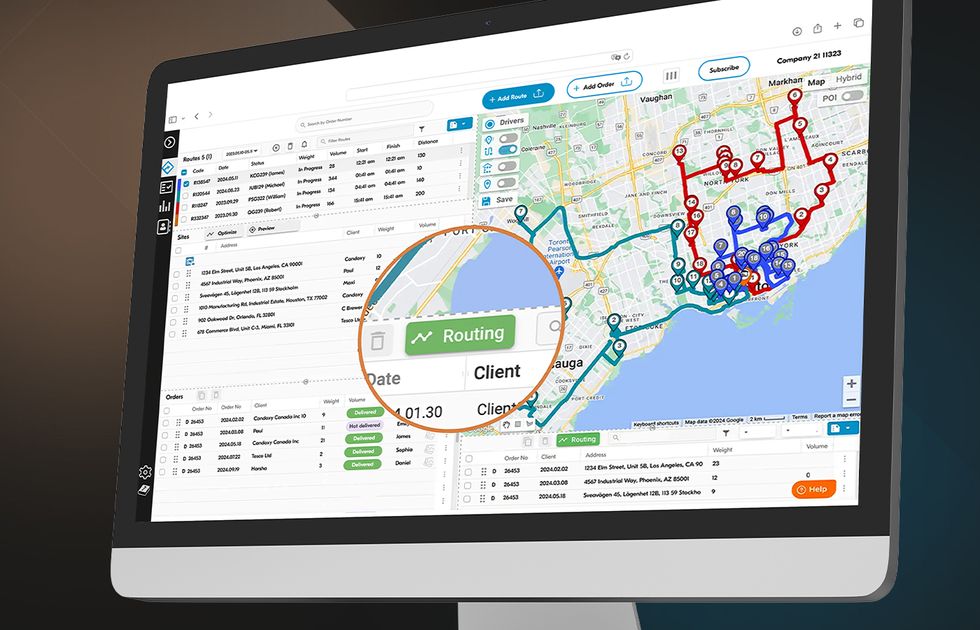
Key Takeaways
- Companies choose cloud-based solutions for scalability, flexibility, cost savings, reliability, and security, which are crucial for modern application development.
- There are three key access models: public, private, and hybrid. Each caters to different needs in terms of control, scalability, and security.
- Best practices for cloud application development include adopting microservices, containerization, an API-first approach, CI/CD pipelines, and strong observability and monitoring.
The adoption of generative AI accelerated through major partnerships with certified cloud service providers. Companies leverage cloud app development to enhance offerings, cut costs, improve customer service, and optimize resources.
For example, McDonald’s partnered with Google Cloud to integrate edge computing into mobile apps, kiosks, and equipment. At the same time, Amazon, Google, and Microsoft introduced in-house AI chips to strengthen their cloud platforms.
Whether you’re creating SaaS platforms or custom apps, mastering cloud development is key. In this article, you’ll learn more about the cloud application definition, popular examples and benefits, as well as challenges and best building practices.
What Is a Cloud Based Application?
First, it’s crucial to understand: what is cloud based application?
Cloud based web application is a solution hosted on remote servers and accessed via the Internet. Unlike traditional, often outdated app, it relies on cloud infrastructure for storage, processing, and scalability.
Modern cloud apps are increasingly designed for multi-cloud and hybrid environments, enabling them to utilize resources from multiple providers seamlessly. This approach enhances flexibility, performance, and resilience by optimizing the strengths of various platforms.
Differences Between Web and Cloud-Based Apps

Now that you know the answer to the key question “What is cloud application development?,” it’s time to move on. Some people tend to confuse cloud-native solutions with web apps, so let’s go through their distinctions to clear things out:
- Web-based apps are accessible only via internet browsers, while most cloud application development services usually have native apps for specific platforms (like Windows, Mac, Linux, Android, or iOS)
- Unlike most web apps, cloud software can work offline and sync the data in the background when connected to the internet
- Cloud-based apps use your local resources, which improves their performance
- Cloud app development services can provide on-demand IT resources and infrastructure to power your software and business operations
Popular Examples of Cloud-Based Applications

There’s no better way to understand what cloud applications development services are than to look at the solutions you’re familiar with:
Web apps
- TripAdvisor helps millions of people review popular tourist destinations, plan their travels, and make reservations via seamlessly integrated booking features.
- Airbnb lets you turn your apartment or spare room into a cash flow or find a vacation place from non-commercial entities.
Desktop apps
- Dropbox is an online storage and collaboration platform that helps you manage, access, and modify files online and offline.
- Jira is synonymous with project management and progress tracking, and, chances are, you’re already using it for your software projects.
Mobile apps
- MyFitnessPal might be the most popular physical activity, nutrition management, and diet tracker with a gigantic food database (and user base).
- Uber is a mobile car-hailing app with a wealth of convenient features that popularized it across customers and freelance drivers.
Benefits of Cloud-Based App Development for Businesses

The top three cloud priorities for businesses cover accessing new technology or development capabilities (65%), unlocking new revenue streams or products (56%), and leveraging industry-specific opportunities (43%). However, these are more long-term cloud based applications development benefits. What pros will you feel almost immediately?
Scalability
Do you want to easily scale your multi-tenant SaaS up or down based on demand? Cloud based application development ensures that companies quickly adapt to changes in workload, seasonal traffic, or growth without needing to invest in or manage physical infrastructure. Access more resources as needed and reduce them when demand decreases.
Flexibility
Cloud-based apps provide the freedom to access and use solutions from any location and on any device. Whether employees work from the office, home, or on the go, they seamlessly connect to the cloud, ensuring consistent performance and productivity. As a result, your business supports remote work and enhances collaboration.
Cost Savings
Forget about large upfront investments in hardware, servers, and other IT infrastructure. Pay for what they use on a subscription or pay-as-you-go model, while the cloud application development company handles maintenance, software updates, and security patches.
For example, one large European company admitted that cloud migration delivered over €20 million in annual cost savings and accelerated development, generating additional value worth millions.
Reliability
65% of businesses reported a notable revenue impact due to technology downtime, while 56% suffered from reputation losses. Require consistent uptime and data availability? Cloud based software development comes with robust disaster recovery solutions.
In the event of failures, they automatically failover to backup systems or replicate data across multiple data centers, ensuring minimal service disruption.
Security
59% of companies consider security as a top infrastructure pain point. Cloud providers heavily invest in security, offering tools such as encryption, multi-factor authentication, and regular security updates. Also, they comply with international standards and certifications, such as ISO 27001, GDPR, and HIPAA.
Types of Cloud Computing Services

Cloud services offer storage, computing power, and software tools to improve your cloud applications development and business processes. The most popular ones include:
- Software as a service (SaaS) — an end-to-end application deployed in the cloud infrastructure that’s owned by a third-party provider. Basically, you rent servers, databases, and computing power for your software. Plus, in multi-tenant SaaS architectures, the cloud provider does all the IT management.
- Infrastructure as a Service (IaaS) — a virtualized IT environment with servers, networking features, and storage to power your business operations. This type of service offers the highest level of control, as you can manage operating systems, databases, middleware, and applications.
- Platform as a Service (PaaS) — a platform for developing cloud-based applications, complete with hardware, operating systems, frameworks, and development tools. These platforms provide a framework to help you build, test, deploy, and update cloud-based products.
- Low-code platforms — a dedicated PaaS environment that allows developing cloud applications with graphical interfaces, templates, and pre-made code. Low-code solutions minimize manual coding and make development possible even for non-technical staff.
- Backend as a Service (BaaS) — a cloud web application development model where you outsource backend processes to providers. BaaS platforms can link your frontend with services like authentication management, social media integrations, notification, and cloud storage via APIs and SDKs, saving time and money.
Types of Cloud-Based Solutions by Access

Developing a cloud based application, select the best solution based on security needs, scalability, and workload requirements:
- Private cloud. A dedicated environment for a single organization, offering high security and control. Best for businesses with strict data privacy or compliance needs.
- Public cloud. This cloud is hosted by third-party providers, and accessible over the internet. It suits businesses seeking low-cost SaaS and other solutions without heavy security demands.
- Hybrid cloud. Combines private and public clouds, allowing data and workloads to move between them. Choose it if you need a balance of security, scalability, and cost optimization.
- Multicloud. Utilize two or more clouds from different providers, offering flexibility and avoiding reliance on a single vendor.
According to IBM, 56% of companies prefer hybrid cloud, 32% opt for multi-cloud, 8% use public cloud, and 4% choose private cloud.
Challenges of Developing Cloud-Based Applications

What challenges affect cloud based mobile application development? 45% of companies are concerned about data security and ethics, 45% mentioned project complexity, and 36% highlighted data issues. Let’s look at these and other obstacles and ways to solve them.
Data Security and Privacy Concerns
Challenge: Data leaks can cause severe financial and reputational damage, especially in sectors like healthcare and finance, where data regulations impose heavy fines.
Solution: Protect against threats with multi-factor authentication, role-based access control, and automatic log-off. Encrypt your databases and communication channels to make the data unreadable to hackers. Ensure data security with backups and recovery plans for disasters or ransomware.
Managing Multi-Cloud Environments
Challenge: Managing multi-cloud environments can be complex, as businesses often face difficulties in integrating services from different providers. You may struggle to ensure consistent performance and maintain security and compliance across multiple platforms.
Solution: Implement unified management tools that centralize control, streamline operations, and provide visibility across all cloud services. Standardizing processes, automating workflows, and using APIs for integration can also help optimize multi-cloud management.
Performance Optimization
Challenge: Maintaining good performance across different cloud platforms is difficult. This is caused by differences in services, resources, and network setups.
Solution: Consider performance monitoring and analytics tools to identify the cause of network, CPU, or RAM bottlenecks. Select the right platform for each workload. And don’t forget about load balancers that process and distribute traffic across servers and databases to optimize the load.
Best Practices for Developing Cloud-Based Applications

How to develop cloud computing application in the most efficient way? Now, let’s look at the modern architecture practices that can help you reduce app expenses, maximize performance, and mitigate risks during development.
Microservices Architecture
Microservices architecture divides complex applications into smaller isolated, independent services. It makes system management and upgrading light years ahead of monolithic architecture with its perplexing dependencies.
For example, a healthcare cloud app may have modules for document management, video calls (telehealth), product catalog, invoice management, and customer portal. Having each module as a microservice allows your dedicated team to work on them independently without affecting the rest of the application.
Containerization
Containerization refers to packaging operating systems together with libraries and supporting dependencies into lightweight executables (containers). This technology makes your software easily portable to any platform and cloud environment.
You need a container orchestration platform like Kubernetes to fully implement containers in your production environment. It can ease such tasks as deployment, rolling out updates, and scaling your containerized software across multiple hosts.
Adopting Kubernetes (or other orchestration platforms) to your workflow requires experience. Still, you shouldn’t throw the idea away because of its complexity: a cloud migration company will help you transfer your apps into Kubernetes.
API-First Design
How to build a cloud computing application placing APIs as the foundation? You start building your cloud app by designing a mockup of your interface. And after validating the design, your team writes the code around it.
This methodology makes a world of difference compared to the code-first approach. Instead of building the code and trying to make use of it, the API-first method laser-focuses your efforts on making the app user-centric.
Besides, the services you create with this approach are easily connected to other platforms via — you guessed it — APIs. It ensures your SaaS developers don’t have to create new code from scratch for other projects.
Automated CI/CD Pipeline
Continuous integration allows multiple contributors to build and deliver code changes into your app simultaneously without disrupting each other’s work. CI tools check whether changes create errors, bugs, or dependency issues. Continuous delivery expands on this practice by automatically deploying the new code to your production environment.
These practices help split cloud-based web and mobile application development into independently managed increments to validate updates. It also allows you to save resources and time by automating most testing and deployment processes.
Observability and Monitoring
How to build a cloud based application for proper observability and monitoring? It involves setting up comprehensive systems that track and log data. By using tools like application performance monitoring (APM) and log management, developers detect issues like slow response times, errors, or bottlenecks in real time.
With observability, businesses gain insights into user experience, infrastructure health, and system behavior. This helps detect problems early, enabling proactive fixes. Monitoring tools also allow developers to set alerts for unusual activities or system failures, ensuring rapid responses and minimal downtime.
Developing Cloud Based Application with Acropolium
Acropolium has been helping companies ideate, design, and develop cloud based applications over the last 15 years. Our services range from IT consulting and cloud migrations to custom web and mobile development.
We also help businesses with outdated and underperforming systems embrace all the benefits of cloud-based architecture.
Here are some of the cases that highlight the experience of our cloud engineers.
SaaS Route Planning Tool for Fleet Management Optimization
A transportation provider implemented SaaS route planning with machine learning for real-time traffic and automated optimization, alongside fleet management features. This led to a 15% profit margin increase, 25% higher customer retention, and 25% better logistics efficiency through improved delivery coordination and resource allocation.

Multi-Platform Video Conferencing App Development
Another client required a conference app with breakout rooms, multi-party conferencing, and HD video, ensuring low latency and strong security. As a result, they got a 15% increase in meeting participation, a 25% boost in productivity, and a 25% rise in customer retention due to seamless integration and a unified UX across devices.

Future Outlook for Cloud-Based Software Development
The cloud applications market is growing fast, from $325.27 billion in 2024 to $639.17 billion in 2028, at a CAGR of 18.2%. This growth is driven by AI, machine learning, IoT, edge computing, remote work, digital transformation, and the rise of hybrid and multi-cloud strategies.

How to develop cloud application according to the latest trends? Let’s talk about the impact of quantum computing and hybrid cloud solutions as the most emerging technologies.
Integrating quantum computing with cloud platforms will increase computing power, transform computing, encryption, and areas such as cryptography, drug discovery, and financial modeling. It enables faster problem-solving and innovation across industries.
The hybrid multi-cloud model, combining private and public clouds, is becoming increasingly popular. First, it allows for the secure storage of sensitive data while allowing for scalability. This optimizes costs and improves disaster recovery through redundancy across environments.
Final Thoughts
Cloud based mobile app development services have become so widespread it’s nearly impossible to imagine a successful enterprise that ignores them. Secure and scalable infrastructures and platforms are known to help businesses enhance their operational capabilities and shave off their expenses.
It’s also no secret that cloud based web application development can be challenging, time- and budget-consuming. However, an experienced provider can share effective practices and steer you away from the harmful ones.
Do you want to switch to a scalable architecture, modernize your legacy software, or build cloud applications from scratch? Acropolium has the technical stack, expertise, and strategy to make it happen. Drop our cloud based application development company a call, and let’s see what we can do for you.










![ᐉ How to Migrate Application to the Cloud [A Practical To-Do List]](/img/articles/migrate-your-software-to-the-cloud/img01.jpg)
![The Benefits of [Cloud-Based ERP Systems] for Large Enterprises and Medium-Sized Businesses](/img/articles/cloud-based-erp-systems/img01.jpg)